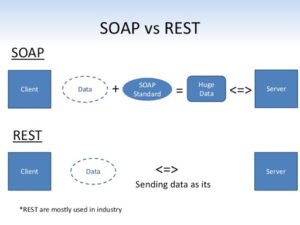Any machine understands a particular language or input so web-services are required to communicate machines with the data between them. There are some essential regulations that aimed to implement some set of restrictions over their communication.
Web-services define the format and type of data that need to be exchanged and specifically a contract, which both machines should be aware of.
This system of communication can be categorized into two types: SOAP and REST. The choice which one to use depends on what really is required, from the business and an architectural point of view.
The goal of this post is to define what REST and SOAP web services are, identify the key SOAP vs REST API differences and help you conclude when to use both of them.
Let’s dive in!
What is REST?
What does REST stand for? It stands for Representational State Transfer.
This is an architectural style determining recommendations for designing loosely coupled apps that use the HTTP protocol for data transmission. It does not prescribe how to implement the principles at a lower level. Instead, with the help of the REST guidelines, developers are able to implement the details according to their own needs. Web services that are built on the REST principles can be called RestFul web services. These services would use the normal HTTP verbs of GET, POST, PUT and DELETE for working with the required components.
In order to create a REST API, you should follow the next architectural constraints:
- Uniform interface. Customers’ requests should look the same. Per example, the same resource should not have more than one URI.
- Client-server separation. The client and the server should interact with each other only through requests and responses.
- Statelessness. There shouldn’t be server-side sessions. Each request should contain all the info the server needs to know.
- Cacheable resources. There should be the info about whether the data they send is cacheable or not in server responses.
- Layered system. There can be several layers of servers between the server and the client who returns the response. This shouldn’t affect the request or the response.
- Code on demand. This is optional. When it’s necessary, the response can contain executable code that the customer may execute.
Why use REST?
Today, Representational State Transfer looks like the most popular option for building public APIs. There are many vivid examples of using it, especially since all major social networks provide REST APIs to let developers seamlessly integrate their apps with the platform. These APIs also provide detailed documentation with all the necessary information you need to pull data through the API.
For example, the WordPress REST API that provides endpoints for WordPress data types to let users interact with the content of a WordPress site remotely and get great outcomes such as building mobile apps with WordPress.

What is SOAP?
What does SOAP stand for? It stands for Simple Object Access Protocol.
This is a messaging protocol for interchanging data in a decentralized and distributed environment. Any application layer protocol (HTTP, SMTP, TCP, or UDP) can be used with SOAP. It returns data to the receiver in XML format. The protocol contains authorization, security, and error-handling. It doesn’t assume direct point-to-point communication, unlike REST.
SOAP acts in accordance with a formal and standardized approach that specifies how to encode XML files returned by the API. SOAP messages contain the following parts:
- Envelope – the starting and ending tags of the message.
- Header that contains the optional attributes of the message. With its help, you can extend a SOAP message in a modular and decentralized way.
- Body, which includes the XML data that the server transmits to the receiver.
- Fault that is aimed to carry the info about errors occurring during processing the message.
Why use SOAP?
It seems that SOAP will likely continue to be used for enterprise-level web services that require complex transactions and serious security. Among the commonly used examples of SOAP, we can remind APIs for CRM tools, payment gateways, financial services, identity management, and telecommunication solutions.
PayPal’s public API is one of the most famous Simple Object Access Protocol APIs. With its help, you can accept PayPal and credit card payments, add a PayPal button to the website, let users log in with PayPal, and apply other actions.
Actually, SOAP can be a helpful option in situations where you cannot use REST.

What are the Benefits of REST Over SOAP?
- Representational State Transfer is typically considered easier to work with, especially coupled with JSON.
- REST allows a bigger choice of data formats. SOAP only allows XML.
- REST is faster. It uses less bandwidth. It’s easier to integrate with existing websites with no need to refactor site infrastructure.
- Advanced performance is also about REST, especially through caching for info that’s not altered and not dynamic.
- With the help of JSON, REST proposes better support for browser clients.
What are the Benefits of SOAP Over REST?
You may say that it is only a matter of personal preference. You will be right as you can achieve the most outcomes using each protocol. However, here’re the most relevant SOAP advantages:
- SOAP proposes built-in retry logic to compensate for failed communications. REST does not have a built-in messaging system.
- When you need strong security, SOAP’s support for WS-Security can come in handy.
- SOAP’s standard HTTP protocol simplifies operation across firewalls and proxies without modifications to the SOAP protocol itself.
- You’d better use SOAP if you need ACID-compliant transactions.
- SOAP is highly extensible through other protocols and technologies. It also supports WS-Addressing, WS-Coordination, WS-Reliable Messaging, and other web services standards.
The best protocol is the one that looks most helpful for your organization, clients you have to support, and flexibility.
REST and JSON are commonly used today as they typically consume less bandwidth and is easier to understand for developers. REST and JSON are more easily consumed by most of today’s web browsers. They have become the defacto technology for the majority of public APIs.
However, SOAP remains a highly demanded and valuable protocol in many circumstances. It offers several alternatives and is also slightly more difficult to develop, but it offers more alternatives and areas to work.





